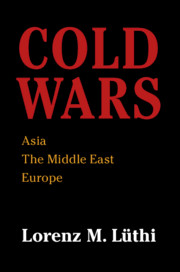Book contents
- Cold Wars
- Cold Wars
- Copyright page
- Dedication
- Contents
- Maps
- Acknowledgments
- Note on Names, Transliterations, and References
- Abbreviations
- Introduction
- 1 From High Imperialism to Cold War Division
- Part I Elusive Unities
- Part II Asia
- Part III The Middle East
- Introduction to Chapters 8 to 10
- 8 Arab–Israeli Relations, 1948–64
- 9 Arab–Israeli Relations, 1964–75
- 10 The Palestinians
- Part IV Alternative World Visions
- Part V Europe between the Superpowers
- Part VI European Détente
- Part VII The End of the Regional Cold Wars
- Notes
- Index
9 - Arab–Israeli Relations, 1964–75
from Part III - The Middle East
Published online by Cambridge University Press: 19 March 2020
- Cold Wars
- Cold Wars
- Copyright page
- Dedication
- Contents
- Maps
- Acknowledgments
- Note on Names, Transliterations, and References
- Abbreviations
- Introduction
- 1 From High Imperialism to Cold War Division
- Part I Elusive Unities
- Part II Asia
- Part III The Middle East
- Introduction to Chapters 8 to 10
- 8 Arab–Israeli Relations, 1948–64
- 9 Arab–Israeli Relations, 1964–75
- 10 The Palestinians
- Part IV Alternative World Visions
- Part V Europe between the Superpowers
- Part VI European Détente
- Part VII The End of the Regional Cold Wars
- Notes
- Index
Summary
The decade after 1964 witnessed two major cataclysmic conflicts—the June War in 1967 and the October War in 1973. Since 1964, American and Soviet influence in the Middle East was growing while the conflict between Israel and its Arab neighbors deepened, leading to June War in 1967 and the subsequent three-year Israeli-Arab stalemate. As the Socialist Camp and Free World lined up behind the Arab side and Israel, respectively, in the June War, the global Cold War superimposed itself on the preexisting regional conflict. Until the fall of 1970, superpower antagonism supported local actors in buttressing the Israeli-Arab stalemate. Egypt’s decision to seek a unilateral arrangement with Israel in late 1970 required the prior weakening of Soviet influence in the region. Thus, while Middle Eastern countries had enticed the superpowers to permeate the region in the second half of the 1960s, one of regional actors—Egypt—took active steps to push one of the hegemons and, in the process, the Cold War out of the region again. When Cairo was unable to engage Washington diplomatically, it decided to go to war in October 1973 to force the Middle East conflict onto the American agenda.
Keywords
- Type
- Chapter
- Information
- Cold WarsAsia, the Middle East, Europe, pp. 212 - 239Publisher: Cambridge University PressPrint publication year: 2020

